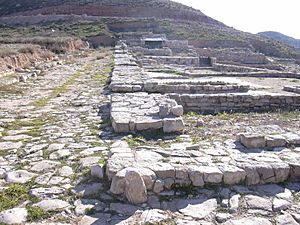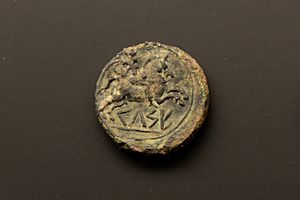Celsa (Roman city) facts for kids
Celsa was a very old and important city in Spain. It was built long before the Romans arrived and grew even bigger during Roman times. You can find its ruins near the modern town of Velilla de Ebro in Aragon.
Archaeologists have recently dug up many amazing buildings. These discoveries help us imagine how grand and busy Celsa once was.
Contents
History of Celsa
Celsa started as an Iberian village called Kelse. The Ilergetes tribe lived there. It was in a great spot along the Ebro River, which was a natural path from the coast into the rest of Spain. The city was built on hills rising from the river. It also overlooked an important river crossing.
From the mid-2nd century to the early 1st century BC, Kelse made its own money. These coins showed images of winged victories, Hercules, and Venus. These coins are a main way we learn about the city from that time.
Later, Celsa had the only stone bridge over the upper Ebro River. This bridge was near Velilla de Ebro. People reported seeing parts of this old bridge in the 1800s.
Celsa Becomes a Roman Colony
In 44 BC, a Roman leader named Marcus Aemilius Lepidus founded a Roman colony here. He was the governor of Hispania Citerior, a Roman province. He settled retired soldiers from the Roman army in Celsa. Each soldier received land to farm and became a Roman citizen.
The new city was called Colonia Celsa Lepida. This was the highest rank a Roman city could have. It was one of only two such colonies in Aragon, the other being Caesaraugusta. Celsa covered about 44 hectares (109 acres). It was a key travel hub, especially for routes to Tarraco (modern Tarragona). About 4,000 people eventually lived there.
Changes and Decline
The city's name soon changed to Colonia Victrix Iulia Celsa. This happened because Lepidus lost his political power in 36 BC. He was sent away by Augustus, who became the new Roman emperor.
Celsa then had a time of great success and wealth. But this period did not last long. By the time of Emperor Nero, Celsa began to decline. Its decline was likely due to a new, growing Roman city nearby, Caesaraugusta. This new city took over most of the important trade routes.
Exploring the City Site
Archaeologists have uncovered entire neighborhoods in Celsa. The streets were paved, and blocks of houses had several floors. These homes were built around courtyards, like typical Roman houses. Many rooms were decorated with beautiful mosaics and paintings. You can also see places where people worked, like warehouses, shops, a market, and a bakery.
Roman architects carefully planned the city's streets. They built them on the terraced slopes. This design helped rainwater flow into the Ebro River. Unlike many other Roman cities, Celsa did not have drains. So, the main streets were built parallel and at right angles to the river.
Excavations have also found parts of interesting homes. Two of the most famous are the House of the Dolphin and the House of Hercules. Both have wonderful wall paintings.
House of Hercules

This house was very large. It was one of the first homes in Celsa to use a Tuscan atrium. An atrium is a central open courtyard. The house had two main stages of building. The first stage, from when the colony was founded, focused on the Tuscan atrium. The second stage, during the time of Emperor Augustus, added an arcaded courtyard to the north.
Rainwater collected in the impluvium (a pool in the atrium floor). This water was stored in a huge tank under one of the rooms. The mosaic floors in the house are very beautiful. Room 1 had walls decorated with paintings in the second Pompeian style. These paintings showed stories of Hercules's famous tasks, which is how the house got its name. The arcaded courtyard led to peaceful, private rooms.
House of the Dolphin
The House of the Dolphin is named after the lovely dolphin designs on its mosaic floors. This large house was changed several times. It started as two separate houses in one city block, or insula. They were combined into one grand mansion by the time of Emperor Claudius (around 54 AD).
This mansion took its final shape in the early 1st century AD. It was organized around two main areas. The first part (rooms 1-14) included public areas and the family's private rooms. The second part (rooms 15-22) was built around an open courtyard. These rooms were for services and enslaved people.
Other Important Buildings
Archaeologists have also found where other public buildings might have been. These include possible temples, the theatre, the forum (the main public square), large water tanks, springs, and cemeteries. The theatre is believed to be under the San José sanctuary. Here, parts of the scaenae frons (stage walls) and rows of seats (cavea) have been found.
Many small items have also been found. These include lamps, red dishes from Pompeii, Iberian pottery, small bronze objects, sculptures, coins, and tiny pieces of jewelry. A museum nearby displays many of these amazing finds.
See also
 In Spanish: Celsa para niños
In Spanish: Celsa para niños



